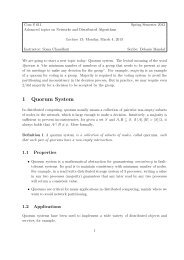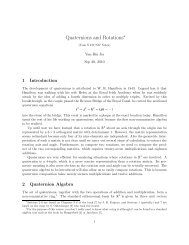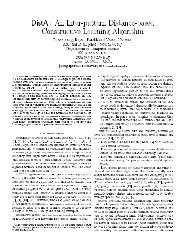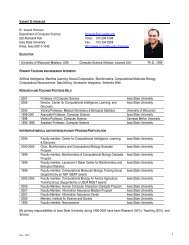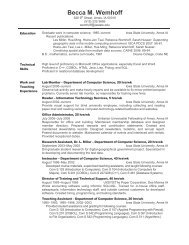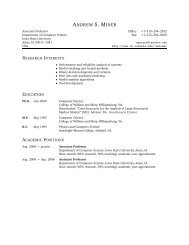Geocasting in Mobile Ad Hoc Networks: Location-Based ... - CiteSeerX
Geocasting in Mobile Ad Hoc Networks: Location-Based ... - CiteSeerX
Geocasting in Mobile Ad Hoc Networks: Location-Based ... - CiteSeerX
Create successful ePaper yourself
Turn your PDF publications into a flip-book with our unique Google optimized e-Paper software.
Forward<strong>in</strong>g<br />
Zone<br />
N<br />
Multicast<br />
Region<br />
I<br />
S (Xs, Ys)<br />
N<br />
I<br />
S (Xs, Ys)<br />
K<br />
DISTs<br />
DISTn<br />
K<br />
(Xc, Yc)<br />
Network Space<br />
(a) <strong>Location</strong>-<strong>Based</strong> Multicast Scheme 1<br />
Multicast Region<br />
(Xc, Yc)<br />
DISTi<br />
DISTk<br />
Network Space<br />
(b) <strong>Location</strong>-<strong>Based</strong> Multicast Scheme 2<br />
Figure 5. Comparison of the two <strong>Location</strong>-<br />
<strong>Based</strong> Multicast Schemes<br />
6<br />
land Rout<strong>in</strong>g Simulator) [4]. MaRS is a discrete-event simulator<br />
built to provide a flexible platform for the evaluation<br />
and comparison of network rout<strong>in</strong>g algorithms. Three protocols<br />
were simulated – multicast flood<strong>in</strong>g, location-based<br />
multicast scheme 1 and scheme 2. We studied several cases<br />
by vary<strong>in</strong>g the size of forward<strong>in</strong>g zone and transmission<br />
range of each node.<br />
4.1 Simulation Model<br />
Number of nodes <strong>in</strong> the network was chosen to be 30.<br />
The nodes <strong>in</strong> the mobile ad hoc network are conf<strong>in</strong>ed to a<br />
1000 unit x 1000 unit square region. Initial locations (X<br />
and Y coord<strong>in</strong>ates) of the nodes are obta<strong>in</strong>ed us<strong>in</strong>g a uniform<br />
distribution. We assume that a node knows its current<br />
location accurately. Also, we assume that each node moves<br />
cont<strong>in</strong>uously, without paus<strong>in</strong>g at any location. Each node<br />
moves with an average speed v. The actual speed is uniformly<br />
distributed <strong>in</strong> the range v, and v+ units/second,<br />
where, we use =2:5. In our prelim<strong>in</strong>ary evaluation, we<br />
only consider average speed (v) of 2.5 units/sec.<br />
Each node makes several “moves” dur<strong>in</strong>g the simulation.<br />
A node does not pause between moves. Dur<strong>in</strong>g a given<br />
move, a node travels distance d, whered is exponentially<br />
distributed with mean 20. The direction of movement for a<br />
given move is chosen randomly. For each such move, for<br />
a given average speed v, the actual speed of movement is<br />
chosen uniformly distributed between [v , ; v + ]. If dur<strong>in</strong>g<br />
a move (over chosen distance d), a node “hits” a wall of<br />
the 1000x1000 region, the node bounces and cont<strong>in</strong>ues to<br />
move after reflection, for the rema<strong>in</strong><strong>in</strong>g portion of distance<br />
d.<br />
Two mobile hosts are considered disconnected if they are<br />
outside each other’s transmission range. All nodes have the<br />
same transmission range. For the simulations, transmission<br />
range values of 200, 250, 300 and 400 units were used.<br />
All wireless l<strong>in</strong>ks have the same bandwidth, 100 Kbytes<br />
per second. Each simulation run simulated 1000 seconds<br />
of execution. For the simulation, a sender is chosen randomly<br />
and a multicast region is predef<strong>in</strong>ed. We assume that<br />
the multicast region is a 300 unit x 300 unit square region<br />
with both X and Y coord<strong>in</strong>ates <strong>in</strong> the range between 500.00<br />
and 800.00. The source performs one multicast per second,<br />
which means that 1000 multicasts have been done <strong>in</strong> each<br />
simulation run.<br />
In our simulations, we do not model the delays that may<br />
be <strong>in</strong>troduced when multiple nodes attempt to transmit simultaneously.<br />
Transmission errors and congestion are also<br />
not considered.



